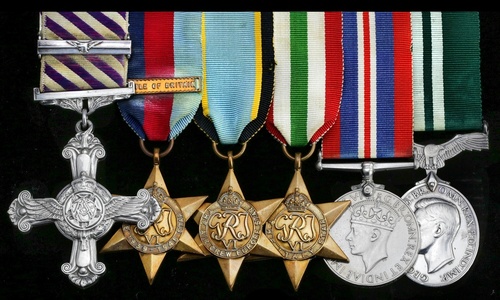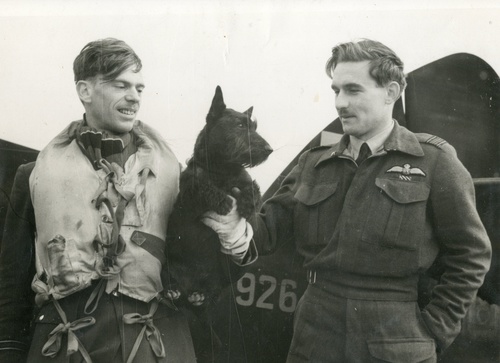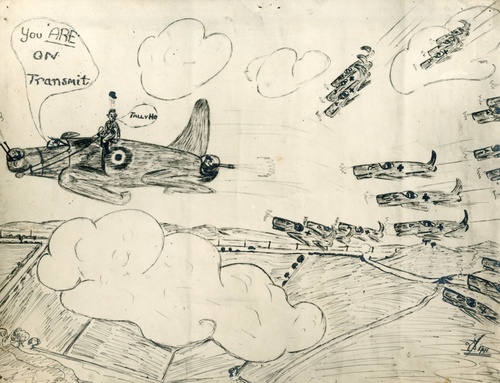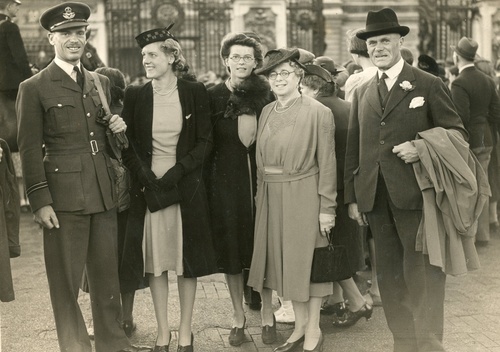Auction: 18001 - Orders, Decorations and Medals
Lot: 36
Sold by Order of a Direct Descendant
The outstanding Second World War night fighter operations D.F.C. and Bar group of six awarded to Squadron Leader A. J. Glegg, Royal Air Force Volunteer Reserve
Having cut his teeth in Blenheims of No. 600 (County of London) at the time of the Battle of Britain, he converted to Beaufighters and teamed-up as Radar Operator to Flying Officer A. D. McN. 'Archie' Boyd, thereby establishing one of the most successful - and enduring - night fighter partnerships of the war
Having destroyed five enemy aircraft over the U.K. in the period May 1941 to March 1942, the intrepid duo carried out a second tour of duty when Boyd took command of No. 219 Squadron in the Mediterranean: five more enemy aircraft rapidly fell to their guns in the summer of 1943, one of them being closed to a range of 50 yards
Distinguished Flying Cross, G.VI.R., with Second Award Bar, the reverse of the Cross officially dated '1942' and the reverse of the Bar '1944'; 1939-45 Star, clasp, Battle of Britain; Air Crew Europe Star; Italy Star; War Medal 1939-45, these four named 'Boots-style' 'S./Ldr. A. J. Glegg'; Air Efficiency Award, G.VI.R., 1st issue (Flt. Lt. A. J. Glegg, R.A.F.V.R.), this with minor official correction and privately engraved '1931-45' after 'R.A.F.V.R.', mounted as worn, contact marks, generally very fine or better (6)
D.F.C. London Gazette 9 January 1942. The joint citation states:
'Squadron Leader Boyd and Flight Lieutenant Glegg- have flown together in numerous night operational sorties. Squadron Leader Boyd is a skilful and determined pilot and he has destroyed three enemy aircraft. Flight Lieutenant Glegg, by his great skill as an observer, has largely assisted his pilot in the successes achieved. Both these officers have shown exceptional keenness and devotion to duty.'
Bar to D.F.C. London Gazette 7 April 1944. The original recommendation states:
'This officer, since the award of the Distinguished Flying Cross in December 1941, has been responsible for the destruction of a further seven enemy aircraft. He held the position of Navigator Radio Leader during his first tour in No. 600 Squadron and now, on his second tour in No. 219 Squadron, where he flies with his Commanding Officer, Wing Commander Boyd, D.F.C.
He holds the outstanding record of never having failed to bring an operational contact to the visual and subsequent destruction of the enemy aircraft.
His continued hard work in the Squadron in the training of new Navigators Radio, which has been accomplished with his very considerable experience (he held the post of 'Training Radio' at headquarters, Fighter Command, whilst on rest between operational tours, from September 1942 to march 1943) has done much to maintain a high standard of A.I. operating, while his personal example has been a source of inspiration to the remainder of the aircrew in No. 219 Squadron.
I strongly recommend this officer for the award of a Bar to the Distinguished Flying Cross.'
Alexander Joseph Glegg was born in London in 1908 and joined the Auxiliary Air Force (A.A.F.) as an Aircrafthand in No. 601 - a.k.a. 'Millionaires' - Squadron in 1931. Over the next two or three years he gained air experience in Harts, flying with a notable cast of pilots, among them Roger Bushell, the mastermind behind 'The Great Escape'. But under pressure with his studies to become a Chartered Surveyor, he had to reduce his commitments in the A.A.F.
Called-up on the outbreak of hostilities in September 1939, he was re-mustered as an Airman u/t Gunner and began training in the Squadron's Blenheims. By the time of his return from a related course at Jurby in early 1940, No. 601 was re-equipping with Hurricanes and he was posted to No. 23 Squadron at Wittering, with whom he operated in Blenheims in June 1940.
No. 600 Squadron: five down - D.F.C.
Commissioned Pilot Officer in the following month, he was next posted to No. 600 (County of London) Squadron at Redhill, from whence he flew two sorties in late September 1940, night patrols over the Tonbridge and Pevensey sectors. His pilot during these sorties was Flying Officer A. D. McN. 'Archie' Boyd, with whom Glegg now teamed-up on a regular basis, thereby commencing one of the most successful - and enduring - night fighting partnerships of the war.
The Squadron having re-equipped with Beaufighters and moved to Predannack in the west country, Boyd and Glegg opened-up their account near Honiton, north-east of Exeter, on the night of 16-17 May 1941, when they destroyed a Ju. 88. A brace of He. IIIs met a similar fate in combats fought north-west of St. Ives on the night of 10-11 October and near Portreath on the night of 2-3 December, 'kills' obtained at 'extremely low altitudes'.
Boyd and Glegg were awarded D.F.C.s but, for good measure, took out another He. 111 south of Colerne on the night of 25-26 January 1942, and a Heinkel 115 float plane south-east of Lizard Point in the first week of March. The latter victory was achieved in unusual circumstances, as described in Hans Onderwater's Gentlemen in Blue:
'One of the other tasks to be carried out by the aircrew of the Squadron was to escort V.I.P. aircraft en route to the Middle East, as far as the Beaufighter's endurance. Returning from such a sortie on 7 March, while they were preparing to land, Boyd and Glegg saw the navigation lights of an aircraft. Control, however, insisted that no other aircraft was around. The pilot opened his throttles and climbed to investigate the matter. They saw a He. 115 float plane at cliff-top level, frantically firing cartridges into the air. Boyd and Glegg did not need much time to realise that this was their prey. They shot down the He. 115 and it crashed in the sea off Lizard Point, adding to their growing number of victims. It was not until they landed again that the 600 crew was told that the Germans must have been lost and were signalling that they were coming in for a landing, believing they were over France.'
Tour-expired, Boyd and Glegg were rested.
219 Squadron: five more - Bar to D.F.C.
In March 1943, Boyd was given command of No. 219 Squadron, with the task of preparing it for an unknown destination overseas. After re-equipping with the latest night fighter version of the Beaufighter - and with a new Air Intercept (A.I) Radar - the Squadron made ready for its departure overseas. With Boyd and Glegg leading, 18 aircraft departed Cornwall for Gibraltar at the end of May 1943, leaving at five-minute intervals on the long flight across the Bay of Biscay. Their eventual destination proved to be Bone in Algeria, from whence, in late June, No. 219 went into action.
The Squadron's account was convincingly opened-up by Boyd and Glegg on the 1 July 1943, when they downed a brace of Ju. 88s. Another Ju. 88 met a similar fate on the night of 25-26 August, north-west of Bizerta. Their combat report takes up the story:
' … Under the direction of the N/R [Glegg] the pilot reduced range during a chase of approximately eight minutes, following target doing considerable evasive action; weaves to port and starboard and dives. Height was reduced to 6,000 feet and range to 2,500 feet, when a visual on a Ju. 88 was obtained and the four exhausts were seen. Pilot closed to 900 feet and opened fire from below and astern, giving a 4-5 second burst. Many H.E. were seen to strike inboard of the engines and the pilot closed to 50 yards and the E/A slowly started to glow on fire to port of the fighter and dived into the sea where three bright flashes were seen.'
Following the advance into Italy, No. 219 covered the landings at Salerno and provided an aircraft at constant readiness to intercept German intruders attacking the rear areas. It was in just such an operation that Boyd and Glegg latched-on to a He. III over Bizerta on the night of 6-7 September 1943. Their combat report takes up the story:
' … Pilot turned to intercept, A.I contact was soon obtained, range three miles, 6,000 feet, well above and climbing to 9,000 feet. A chase followed of about six minutes; target was weaving very slightly port to starboard. Pilot jockeyed for position, having regard to the position of the moon, and closed in on starboard side of the target and from below; this was identified by the four exhausts and wings as a He. III. Closed in below and behind tom 300 feet, opened fire with a one second burst and the target instantly blew up in the air. Beaufighter pulled up to port to avoid wreckage, target spun down in flames and burst as it struck sea.'
Finally, on the night of 18-19 September, pilot and radar operator pursued and destroyed another He. III, bringing their tally of confirmed 'kills' to 10.
The Squadron returned to the U.K. in January 1944 and, four months later, Boyd's and Glegg's exceptional partnership ended: they had flown together on 600 occasions.
Released from the R.A.F. as a Squadron Leader at the war's end, Glegg was awarded the Air Efficiency Award and became a Chartered Surveyor. He died in 1992; 'Archie' Boyd retired to France and died in April 2014.
Sold with a large quantity of original documentation and photographs, comprising:
(i)
The recipient's R.A.F. Flying Log Books (3), comprising Air Gunner's Log Book (pre-war Form 414 type) for services in the Auxiliary Air Force in the period February 1931 to October 1934, his name inscribed on an overlaid label to the front cover; R.A.F. Pilot's Flying Log Book - another Form 414 type - covering the period from his call-up in August 1939 to November 1943, with his name in ink over struck name of 'Scott, R.L.' and opening red ink inscription from Wing Commander Baynes, 'Suggest you procure a modern type log book'; the first page records flights made by R. L. Scott in February 1932, with a line through the opposite summary of hours flown, prior to commencing with Glegg's wartime service; and his R.A.F. Navigator's, Air Bomber's and Air Gunner's Flying Log Book (form 1767 type), covering the period December 1943 to July 1945. Entirely as issued to - and used by - the recipient and a complete record of his flying career.
(ii)
Central Chancery letter regarding his D.F.C. investiture on 14 July 1942, together with a related congratulatory letter from the Chartered Surveyors Institution, dated 12 January 1942; Buckingham Palace forwarding letter for the award of the Bar to his D.F.C., in the name of 'Squadron Leader Alexander J. Glegg, D.F.C.', and a related congratulatory message from Air Vice Marshal Sir H. Lloyd; and an Air Ministry letter informing Glegg of the award of the Air Efficiency Award.
(iii)
A small photograph album compiled by Glegg during the period 1939 to 1941, with scenes from Biggin Hill, Tangmere, Hornchurch and Wittering; it includes some excellent portrait photographs of fellow airmen, approximately 72 images, well-captioned with names.
(iv)
A larger, more comprehensive wartime photograph album, commencing with 54 photographs of his time in No. 600 Squadron, with pilots relaxing at the Polurrion Hotel and around the cliff tops of Mullion Cove and the Lizard, Cornwall; these followed by a family photograph taken at his D.F.C. investiture at Buckingham Palace in July 1942 and then focussing on his time in No. 219 Squadron in North Africa, with over 200 photographs showing fellow pilots, soldiers, daily life and some outstanding images of local people and landscapes: an important photographic record of 600 and 219 Squadrons.
(v)
A further 45 loose-leaf photographs, both pre- and post-war, showing early training at Lympne Camp in 1931, the Hendon Air Display of 1935, family and friends, parades and commemorations.
(vi)
A musical score, created by the airmen of - and dedicated to - No. 600 Squadron, and 'Flight Lieutenant Glegg and Squadron Leader Boyd in Particular'; titled 'Don't Forget the Rear Gunner!', the score is a creative and cheerful text giving a personal insight into Glegg's popularity and personality.
(vii)
A file marked 'Secret', with Fighter Command night interception data, 1942; two personal combat reports, carbon and blue copies, describing actions over Bizerta; further paperwork relating to the No. 600 Squadron's training scheme; a notebook relating to air pilotage, bombing and gunnery; another on methods of fighter interception, with annotation and two hand-drawn colour maps of low flying tests from Treleaver, Cornwall, dated 14 June 1942.
(viii)
His R.A.F. Service and Release Book, date stamped 8 August 1945, and an Air Ministry letter regarding him relinquishing his R.A.F.V.R. commission, dated 25 May 1954.
(ix)
A comprehensive archive of newspaper cuttings relating to the loss of an aircraft flown by Lindsay Robertson Glegg, at Cheam, Surrey, in April 1934; the plane was seen to nose-dive after circling his home and he was extricated from the wreckage by his father; The London to Melbourne Air Race, October 1934 Bulletin, together with photographs of some of the air crew and aeroplanes taking part, including a crashed biplane; and The Battle of Britain, August-October 1940, H.M.S.O., original copy first published 1941; and further commemorative service booklets and menus.
(x)
The recipient's wartime Bubble Sextant, Mk. IX. BM. No. 10010/44, in original wooden box of issue, with leather strap.
Subject to 20% VAT on Buyer’s Premium. For more information please view Terms and Conditions for Buyers.
Sold for
£8,500











